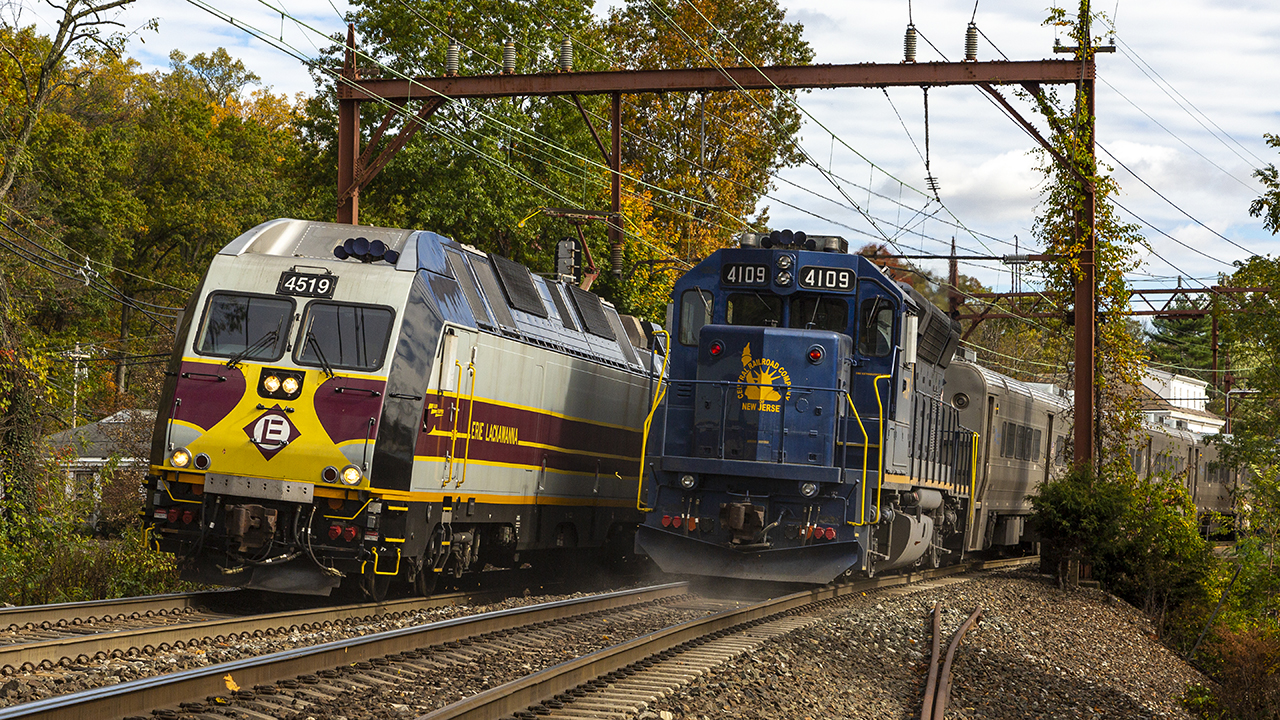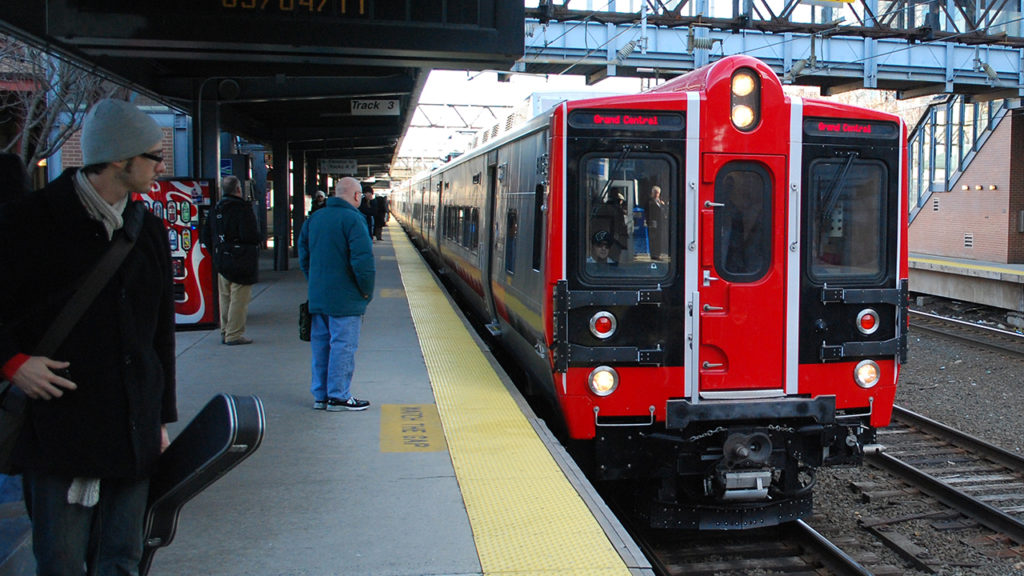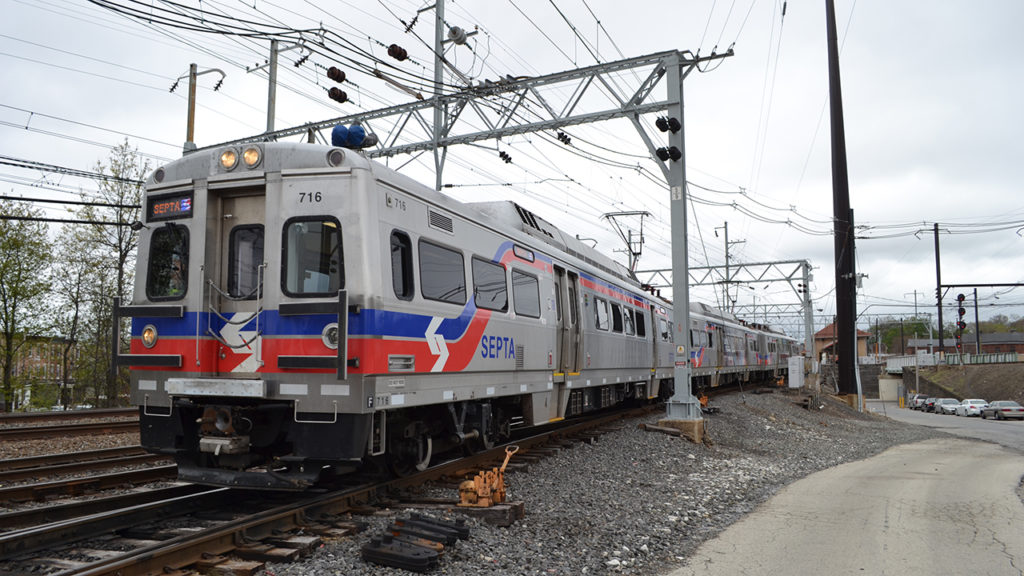
NJT, SEPTA, Metro-North at 40
Written by David Peter Alan, Contributing Editor
Heritage schemes: New Jersey Transit ALP45-DP 4519 in Erie-Lackawanna colors and GP40PH 4109 in its original Jersey Central Lines livery at Millburn, N.J., on the Morris & Essex Line. NJ Transit photo.
RAILWAY AGE, APRIL 2023 ISSUE: Imagine going back 40 years to early 1983. The only passenger trains running along much of Amtrak’s Northeast Corridor (NEC) were operated by Amtrak itself. Otherwise, what was (and still is) the nation’s busiest passenger railroad line stood empty and silent. The trains that normally carried the “9-to-5 army” of commuters, along with other riders at other times, were all sitting in their yards.
When that happened, Consolidated Rail Corp. (Conrail) was forced to stop running local passenger trains, and the new state-sponsored operators had not yet worked out the rules by which the trains would run. On both sides of the Hudson around New York City, and from Philadelphia outward in Pennsylvania, the local trains were sitting still. The sole exception was the Long Island Rail Road, which had operated under its own flag since 1834 and had never been part of Conrail.
Three new railroads—New Jersey Transit Rail Operations, SEPTA Regional Rail and Metro-North—operated for only two months after they were founded, until they were halted by labor disputes. It would take into April 1983 before the ones serving New York City started up again; SEPTA was out of service until July 3.
Conrail had risen from the ashes of seven bankrupt Northeastern railroads that ran freight trains throughout the Northeast and some of the Midwest, and passenger trains as far west as Chicago and St. Louis. They included the short-lived and ill-fated Penn Central, the almost as short-lived Erie-Lackawanna, and more-local railroads like the Central Railroad of New Jersey and the Reading, centered on Philadelphia. Those were the railroads that operated local passenger trains south of Boston, north of Washington, D.C., and especially in the New York, New Jersey and Philadelphia areas.
Conrail was established by the Regional Rail Reorganization Act of 1973 (3R Act). It was incorporated in 1974 and kept those trains running, starting on April 1, 1976. Amtrak had taken NEC operations and long-distance trains off Penn Central’s hands in 1971, while the last Erie-Lackawanna long-distance trains had bitten the dust the year before. Conrail discontinued a few limited-service commuter lines in the late 1970s and transferred Southside service in Boston to the Boston & Maine (which had historically run Northside service) in 1977.
Then along came the Northeast Rail Service Act in 1981, which mandated that Conrail give up its local passenger operations after a transitional period of only 18 months. Time would be up as 1982 turned into 1983. Before the deadline date, Conrail discontinued some local services, while Amtrak picked up the limited commuter operation between Baltimore and Washington, D.C. that later became the MARC Penn Line.
Railway Age Contributing Editor Jim Blaze worked at Conrail at the time and participated in the transition. He said that Conrail management and the transit agencies wanted a deal to transfer the trains from Conrail operation to local providers. The benefit for the local providers would be local control of the services. Conrail wanted out, too. Its management had significantly underestimated the cost to rehabilitate the lines for freight service on account of deferred maintenance. Beyond that, deferred maintenance had also caused the anticipated cost of rehabilitating Conrail’s lines that hosted local passenger trains to increase, as well. There also were not enough employees to keep maintaining the lines, which gave Conrail an additional reason to look for other operators.
As 1982 went and 1983 came and Conrail was out, there were suddenly three new railroads in the region. Each had a difficult birth experience, not only for their managers and other employees, but also for their riders.

Walter E. Zullig was General Counsel for New York’s Metropolitan Transportation Authority (MTA) and filed the original incorporation papers for Metro-North. It was known as the Metro-North Commuter Railroad Co. when it was formed in September 1982. Peter Stangl was Metro-North’s first president, and the railroad was part of the MTA. Zullig told Railway Age that the MTA had been involved in tripartite negotiations with the Connecticut Department of Transportation (ConnDOT) and the trustees of Penn Central since 1971. Sen. Jacob Javits (R-N.Y.) secured an amendment to the statute, which said that Conrail would take over the contracts, but the details of that takeover were contentious, and the matter went to arbitration.
At its founding, Metro-North had about 9,500 employees, many of whom belonged to 17 different unions. According to Zullig, there were ongoing negotiations with Amtrak, Conrail and NJ Transit, as well as with the unions. The labor talks eventually broke down, and the United Transportation Union (UTU) started a strike on March 7 over crew sizes and assignments. The strike lasted six weeks, and the crews went back to work on April 18, when the dispute went to arbitration.
Zullig remembered the strike, and how he worked temporarily as a trainmaster to help move Amtrak trains over the railroad. He told Railway Age that, while he always took legal files with him to review while he was working in the tower, he didn’t always get that work done. On one occasion, he had to go out to a bridge and open it by hand for an Amtrak train. On another occasion, he had to work with power equipment, not exactly the subject matter for a course in law school. He noted that most of the freight ran during the day, so he seldom had to get a freight train through on his “night job.”
Zullig recalled that a lot of people at the MTA complained about Conrail, and that Metro-North turned out much better. He pointed to improvements that Metro-North has made over the years: electrification of the Upper Harlem Line to Southeast Station in Brewster in 1984, the overhaul that returned Grand Central Terminal to its historic grandeur, rehabilitating the Park Avenue Viaduct, and other features.
Although he is retired, Zullig is still active with the National Railway Historical Society (NRHS) and the Metro-North Commuter Council, an officially constituted advisory committee. He concluded our interview by saying, “It’s good that Metro-North was created. We did the job and we did it right. I’m very glad that I played a role in it. We have a blogging group of about 100 management retirees, and we’re all glad that we’ve been there.”
NJ Transit started as a bus company in 1979, when utility Public Service wanted out of the bus business. At that time, Conrail was running the trains in New Jersey that were once operated by the historic Pennsylvania, Lackawanna, Erie and Jersey Central railroads. The Commuter Operating Agency (COA) within the New Jersey Department of Transportation provided oversight and financial support. The bus side (including the Newark City Subway) and rail side were separate then.
The transition seemed smooth at first, as 1982’s Conrail trains in New Jersey became 1983’s NJ Transit trains, under the auspices of the newly formed New Jersey Transit Rail Operations, Inc. (NJTROI). The Conrail practice of discontinuing lightly used lines continued during the early days of NJTROI, but the rest of the network kept running, with little change at first. As on Metro-North, it was not to last.
Labor relations were also contentious in New Jersey, and a strike began on March 1. The agency was demanding a $6,000 pay cut for conductors, but later relaxed that demand. Agency managers devised a strike contingency plan. Like Zullig at Metro-North, some managers had an unusual work assignment during the strike, which lasted 42 days and ended on April 12. The trains came back, and NJT managers eventually built the state’s rail system into what it is today. The re-electrification of the Morris & Essex (M&E) Line and its branches to Montclair and Gladstone, which began under Conrail, was completed. The fare structure was rationalized. MidtownDirect service on the M&E to New York Penn Station started in 1996. Secaucus Junction Station, which hosts trains from both the Newark and Hoboken Divisions, opened in 2003. While some lightly served lines lost their trains in the early days and others later experienced cuts, there are also lines that have gained service over the years, like full service on the Montclair line, which was restored for the first time in 34 years when the Montclair Connection opened in 2002. NJT brought the Atlantic City Rail Line back, as well, with trains to and from Philadelphia.

The transition on the Pennsylvania side of the Philadelphia area was much more difficult and contentious. It included a 108-day strike and a campaign to blur, and even obliterate, the line between local rail transit (like the Broad Street and Market-Frankford Lines) and the lines that had been part of Conrail, according to longtime manager Thomas R. Hickey.
At the time, Hickey was a transportation planner for Montgomery County, the county to the northwest of Philadelphia that includes Norristown. According to Hickey, then-SEPTA General Manager David Gunn called for deep cuts to save money and keep the electrified service going. At the time, PennDOT eliminated diesel-hauled trains to such places as Reading, Bethlehem and New Jersey beyond West Trenton. The sole exception was the service to Newtown, beyond Fox Chase. It ran independently as the “Fox Chase High-Speed Line” with RDC cars built by the Budd Company and owned by the City of Philadelphia until they were no longer serviceable. Hickey told Railway Age that Philadelphians colloquially refer to metropolitan transit lines as “high-speed” lines, like the “Norristown High-Speed Line” or the “PATCO High-Speed line” to South Jersey.
Hickey said that, when the time came for the transition away from Conrail, Gunn considered using the newly formed Amtrak Commuter Services subsidiary, but chose instead to create “regional high-speed lines” and remove many of the signs of “railroad culture” from those lines. Conductors no longer wore “railroad uniforms” and new uniforms looked like the ones bus drivers or streetcar operators wore. One engineer and one conductor were assigned to each train, but other crew members were dubbed “passenger attendants” and remained on standby for a call to work a train, instead of having
a schedule.
A 108-day strike, the longest in the agency’s history, started in March. Members of 13 unions struck, and a key issue was SEPTA’s demand that train conductors accept pay cuts after SEPTA had already cut the number of those workers by more than half. Eventually, a level of distinction between the regional rail lines and local transit gradually came back, even though it took a few years, according to Hickey. There were capital improvements, too, but they were not made by SEPTA. The City of Philadelphia made them within its borders, under the leadership of Ed Tennyson, PennDOT’s Deputy Secretary for regional transit during the 1970s. The rail side recovered some autonomy and crews regained their “railroad uniforms” later in the 1980s. By shortly after 2000, the rail side had become semi-autonomous, if not
fully independent.
There was not much time to prepare for the transition from Conrail to the newly formed local railroads, nor was there much of a transition. Somehow, the new managers got the hang of their new jobs on the new railroads, as railroaders often do. Today, all three railroads face challenges, including financial ones.
Still, riders on most lines kept their trains. Service has improved over the years on some lines, declined on a few others, and stayed about the same on many. The situation could have been worse 40 years ago, but determined managers and rail labor got together on terms somehow, and the trains kept running.
They still do.



